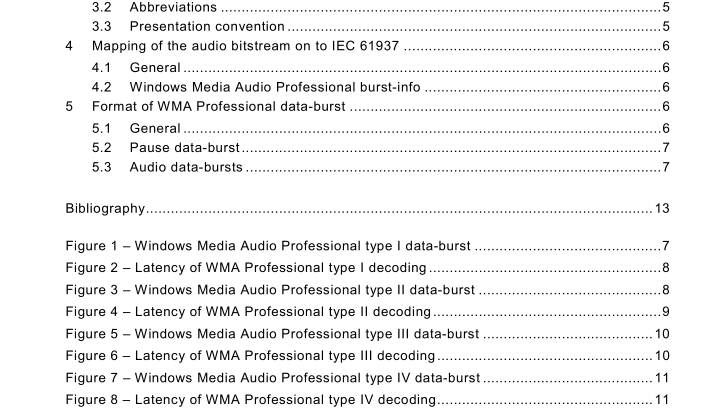IEC 61937-8:2006 pdf download – Digital Audio – Interface for non-linear PCM encoded audio bitstreams applying IEC 60958 – Part 8: Non-linear PCM bitstreams according to the Windows Media Audio (WMA) Professional format
1 Scope
This part of IEC 61 937 specifies the method for the digital audio interface specified in IEC 60958 to convey non-linear PCM bitstreams encoded in accordance with the WMA Professional format.
2 Normative references
The following referenced documents are indispensable for the application of this document.
For dated references, only the edition cited applies. For undated references, the latest edition of the referenced document (including any amendments) applies.
IEC 60958 (all parts), Digital audio interface
IEC 61 937-1 , Digital audio – Interface for non-linear PCM encoded audio bitstreams applying IEC 60958 – Part 1: General
IEC 61 937-2, Digital audio – Interface for non-linear PCM encoded audio bitstreams applying IEC 60958 – Part 2: Burst-info
3 Terms, definitions and abbreviations
For the purposes of this document, the following terms, definitions, abbreviations and presentation convention apply.
3.1 Terms and definitions
3.1.1
latency
delay time of an external audio decoder to decode a WMA Professional data burst, defined as the sum of two values of the receiving delay time and the decoding delay time
3.2 Abbreviations
ATSC Advanced Television Systems Committee
MPEG The Moving Pictures Expert Group, a joint committee of ISO and IEC
ITU-R International Telecommunication Union, Radio communication Bureau
WMA Windows Media Audio
3.3 Presentation convention
F872h
Value ‘F872’ in hexadecimal format
4 Mapping of the audio bitstream on to IEC 61937
4.1 General
The coding of the bitstream and data-burst shall be in accordance with IEC 61 937-1 .
4.2 Windows Media Audio Professional burst-info
The 1 6-bit burst-info contains information about the data that will be found in the data-burst in accordance with Table 1 .
5 Format of WMA Professional data-burst
5.1 General This clause specifies the audio data-burst for WMA Professional. Specific properties such as reference points, repetition period, the method of filling stream gaps, and decoding latency are specified for each data-type. The decoding latency (or delay), indicated for the data-types, should be used by the transmitter to schedule data-bursts as necessary to establish synchronization between picture and decoded audio.
5.2 Pause data-burst
Pause data-burst for WMA Professional Types I, II, III, and IV are given in Table 2.
5.3 Audio data-bursts
5.3.1 The data-burst for WMA Professional Type I WMA Professional Type I is primarily intended for use at sample rates above 48 kHz (for example, 88,2 kHz or 96 kHz). The IEC 60958 link should be operated at the sample rate of the decoded audio. The WMA Professional bitstream consists of a sequence of WMA Professional frames. The data-type of a WMA Professional Type I data-burst is 1 2 h and the subtype is 0 h. A WMA Professional Type I frame represents 4 096 samples of each encoded audio channel (left, centre, etc.) transmitted in two sequential data-bursts. The data-burst is headed with a burst- preamble, followed by the burst-payload. The burst-payload of each pair of data-bursts of WMA Professional Type I data shall contain one complete WMA Professional frame. The length of the WMA Professional data-burst will depend on the encoded bit rate (which determines the WMA Professional frame length).
The data-bursts containing WMA Professional Type I frames shall occur at a regular rate, with the reference point of each WMA Professional frame (bit 0 of Pa of the first of the pair of data- bursts) beginning (except in the case of a gap) 4 096 sampling periods of the audio after the reference point of the preceding WMA Professional frame (of the same bit-stream-number).
5.3.2 Latency of WMA Professional Type I decoding The latency of an audio decoder to decode a Windows Media Audio Professional data-burst is defined as two Windows Media Audio Professional frames, plus a decoding delay of two-thirds of a Windows Media Audio Professional frame. This corresponds to a latency of 1 23,84 ms at 88,2 kHz and 1 1 3,77 ms at 96 kHz sampling frequency, where the maximum frame size is 4 096 samples per frame.
